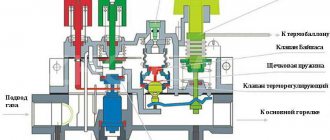The history of gas stoves dates back to 1825. Then gas factory worker James Charm patented his invention - the first gas stove. From that moment on, the equipment has firmly established itself practically in kitchens, delighting its owners with ease of use and maintenance, efficiency, reliability and durability.
Gas stoves are constantly being improved, with new useful options and programs appearing in functionality. One of them is electric ignition. Let's find out what electric ignition of a gas stove is, what its advantages are and how to fix it if it breaks.
Types of electric ignition
Electric ignition of a gas stove is a function that is present in most modern models of household appliances. Its task is to light the burners without the use of additional means : matches, lighters.
Reference . Electric ignition allows you to safely ignite gas and protect the user from possible burns and other injuries.
There are two types of electric ignition:
- Mechanical (semi-automatic). It is implemented by turning the gas supply knob on the panel and pressing the special electric ignition button at the right time. When pressed, a spark is supplied to the burners and the gas on the burner is ignited.
- Automatic . This happens by lightly pressing and turning the knob on the panel that supplies gas to the burner. That is, gas is supplied and a spark occurs at the same time. Moreover, the spark is multiple, in contrast to the mechanical push-button ignition option. Operation is indicated by clicks when pressing and turning the knob.
The main difference between these two electric ignition systems is the degree of human participation at the moment of closing the mechanism chain.
The main advantages and features of stoves with electric ignition
Advantages of kitchen gas stoves with electric ignition system:
- protecting the user from possible burns when gas ignites;
- no need to purchase matches and lighters;
- simplifying the ignition process and speeding up cooking;
- ease of control of the device with electric ignition.
The system has only one drawback : if there is a power outage, the user will not be able to light the gas, since the mechanism does not work without power supply. Therefore, you should always have a box of matches hidden at home in reserve.
Reference . The presence of the electric ignition function does not change the essence of the operation of the gas device and has almost no effect on its final cost. But it makes using technology more convenient.
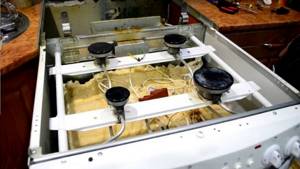
Electrically ignited stoves have minimal differences from other models of gas devices:
- electric ignition button with a spark drawn next to it - mechanical system;
- handles that supply not only gas, but also a spark - automatic ignition;
- white ceramic candles built into each burner;
- a power cable 1.5-2 m long, which comes out of the back wall of the device.
The mechanism itself is located inside the plate body and remains invisible to the user.
Interesting things on the site:
Types of modern gas stoves for the kitchen
Gas stove gas control device
How to choose a gas stove with an electric oven
Advantages and disadvantages

Many users cannot give up the habit of using matches. Therefore, they purchase outdated models, thinking that the electric ignition function adds cost to the device. In fact, this appliance skill will cost you nothing.
Using the stove becomes convenient; you don’t have to buy a supply of matches or frantically search for a reliable lighter that can work for a long period. The function protects against the possibility of getting burned. If you have previously used an electric stove, it will be difficult to refuse automatic ignition.
The only disadvantage is the inability to use the task when the lights are off. Therefore, make sure that you still have a tool for igniting a gas stove at home.
Requirements for a stove with electric ignition
The main requirement for a device with electric ignition is to connect the device to an electrical network with a voltage of 220 volts.
For this purpose, the stove comes with a cord - a three-core cable with a cross-section of at least 1.5 mm, ending with a grounding plug. An outlet with a grounding circuit is installed near the installation site of the device.
To ensure additional safety, a special residual current device is installed on the common incoming panel, which blocks the network in the event of a current leak.
Important . It is better to invite an electrician to carry out the work.

Similarities between devices
The similarities are given below:
- In order for any type of electric ignition to work, it is necessary to connect the stove to an electrical network.
- The need to install a grounded outlet.
- A stable voltage is required . If there are problems with voltage in the house, then it is better to purchase models that are most resistant to various surges. Domestic options are most adapted to such working conditions.
- The need to install separate wiring if there is no grounded outlet. In this case, a three-core wire is required, with a cross-section of at least 1.5 mm (in diameter). In addition, the electrical panel must be equipped with a 16A .
- Possibility of operating a gas stove without electricity . You just have to use matches or a lighter. Therefore, a power outage will not lead to starvation of the entire family.
- The need to replace the transformer in case of ignition failure.
- Composite electronic elements are sold in specialized stores.
- The most vulnerable parts are brass contacts ; they fail after a while.
- Possibility of independent connection of the stove.
Impact piezo ignition circuit
Impact piezo ignition was installed on gas stoves in Soviet times, and is now almost never used. It can only be found in gas instantaneous water heaters.
The mechanism is complex and consists of the following elements:
- piezoelectric element;
- high voltage wire;
- insulator;
- a tube;
- striker;
- striker cocking rod;
- spring.
The principle of operation of the mechanism is based on a shock pulse - a short-term piezoelectric effect created by pressing a button.
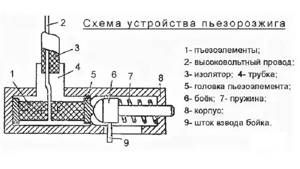
Action diagram:
- The button is pressed.
- The striker is erected and hits the piezoelectric element hard.
- At the moment of impact, a voltage of 10-15 kV is generated.
- The generated voltage is supplied through a high-voltage wire to the gas burner, where sparking occurs.
- The gas on the burner ignites.
The voltage generated is not dangerous to the user , but it is quite enough to ignite the gas.
Device differences
The differences are presented in the table.
| Criterion | Mechanical view | Automatic view |
| Additional button | Necessary, it is the additional button that is responsible for supplying the spark. | Need not. The method of supplying a spark is by turning the power regulator. |
| System complexity | A simpler system | More complex system |
| What a spark | One-time | Repeated (about 50 electrical impulses per minute). |
| Where is it most common? | In gas stoves, ovens | In hobs |
| Save time | Quite a long process | Significantly saves time |
Scheme of modern electric ignition
Many gas devices are equipped with a modern ignition circuit, mainly comfort stoves. The method is implemented using various electrical circuits, but the principle of operation is the same for all - a voltage source is required to ignite the gas.
Basic elements of a modern mechanism:
- ignition button or rotary knobs;
- transformer;
- capacitor;
- thyristor – semiconductor element;
- candles.
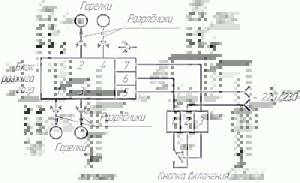
Scheme of work:
- Pressing a button or drowning and turning the knob on the panel.
- Applying voltage to the capacitor, which begins to charge.
- When the capacitor is fully charged, it supplies a pulse of current to the thyristor.
- The thyristor opens and the capacitor quickly discharges through the thyristor and the primary windings of the transformer.
- High voltage pulses are induced in the transformer.
- Sparking occurs on the burners in the candles. The spark is used on the burner to which the gas supply is open.
- The gas on the burner ignites.
The mechanical and automatic options for electric ignition are based on this scheme .
What to do if the electric ignition does not work
No matter how perfect a mechanism is, there is always a way to break it. Same with electric ignition. Most often, the electric ignition refuses to work or clicks if:
| 1 | The spark plug is dirty. You can fix the problem at home: a greasy coating on the spark plug prevents the formation of a spark. It can be easily removed with an alcohol-soaked cotton swab or cloth. |
| 2 | Voltage fluctuates frequently. |
| 3 | Incorrect operation occurs. For example, if you tried to turn on the electric ignition when the flame diffuser was removed from the burner. In cases 2 and 3, it is better to call a specialist. |
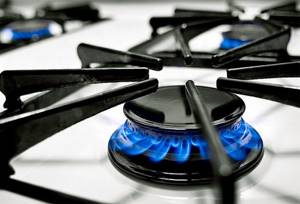
How to understand that the electric ignition is broken: methods of self-repair
Like any mechanism, electric ignition is susceptible to breakdowns. The following signs will indicate the presence of malfunctions in the system :
- The gas stove does not ignite using electric ignition when pressing a button or turning a knob;
- When turned on, clicks are heard, but a spark does not appear;
- after releasing the button or handle, the system does not stop working;
- the device operates without pressing a button;
- in the common panel the circuit breaker is triggered.

Common causes of such system malfunctions:
- lack of contact;
- contamination of buttons, handles or other parts of the system, which leads to a short circuit;
- damage to the ceramic shell of the candle;
- transformer combustion;
- oxidation of contacts, which prevents the normal closure of the circuit.
Some breakdowns can be repaired yourself without involving gas service specialists. This requires:
- inspect the stove and all ignition elements;
- make sure that the burners themselves are in good working order by lighting each one in turn with a match;
- thoroughly clean the spark plugs and button from dirt, carbon deposits, and grease;
- If water gets on the button or burner handles, wipe them thoroughly and let them dry;
- Clean oxidized or burnt contacts to a homogeneous metal;
- If a breakdown of system elements is detected, replace them with new ones.
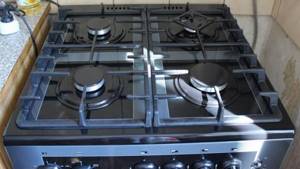
If you are unable to find the cause of the breakdown on your own or do not have special skills , entrust the diagnostic and repair process to a specialist. An experienced technician can easily determine why the system is not working and will repair it efficiently, guaranteeing safety when using the equipment.
Reference. Most often, craftsmen have to replace failed candles and ignition units in the electric ignition system of a gas stove.
For what purposes are they best suited?
When buying a hob, you should give preference to a model with automatic electric ignition. This will avoid having an extra button and maintain a beautiful appearance. Gas stoves can be selected with any type of electric ignition. The additional button is not visible and does not take up space.
For safe operation of the stove, it is necessary to follow the manufacturer’s recommendations, which are specified in the instructions.

When using a gas stove, you often have to deal with the problem of having matches in the house or the functionality of the igniter purchased specifically for convenience. To save users from such difficulties, electric ignition was invented, which allows you to light a gas burner by pressing one button. To choose a stove with such a system, you need to know the features of its operation, advantages and disadvantages.
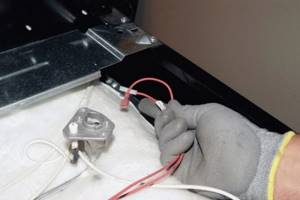
"Mechanics" or "automatic"
Electric ignition, like a car’s gearbox, can be mechanical or automatic. On a stove with mechanical electric ignition there is a button that must be pressed after turning the switch. The high voltage circuit closes and a spark occurs, which ignites the gas. With automatic electric ignition, a spark is generated immediately when you turn the switch while simultaneously pressing it.
Today, special ceramics are used in the production of piezo igniters. The design of the piezo igniter is simple. There is spring inside. In the original position it is stretched. If the button is pressed, it completely relaxes the spring. The pestle hits the crystal with full force and ensures that a spark can be created.
Useful accessory for a gas stove
There are many accessories for a gas stove. The list of kitchen accessories is long and other useful items come in handy when using a gas stove. A useful accessory that should not be missing is a windbreaker. This is responsible for ensuring that the gas stove or flame is protected from the wind and does not lose energy. The windshield may already be included in the package or purchased separately as an accessory.





